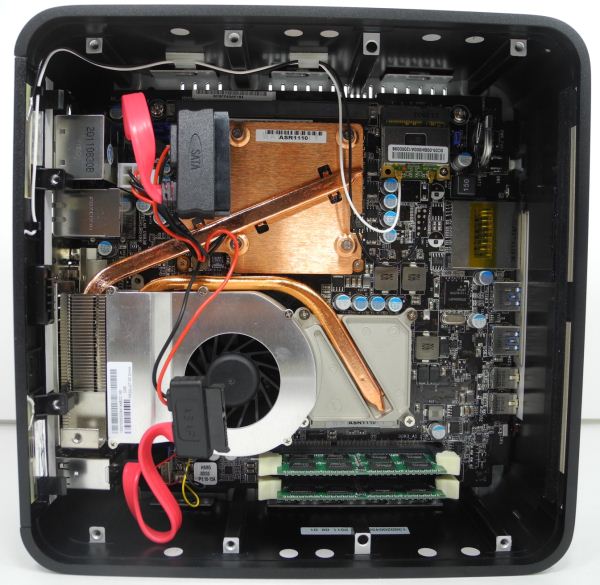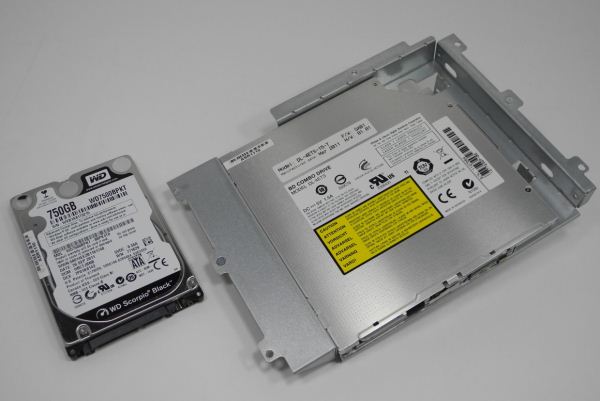ASRock's High-End Vision 3D 252B HTPC Review
by Ganesh T S on May 7, 2012 6:15 AM EST- Posted in
- Home Theater
- Sandy Bridge
- HTPC
- GT 540M
- NVIDIA
The ASRock Vision 3D 252B is primarily built out of notebook components, and it is not possible for the average enthusiast to build such a system with off-the-shelf components.
Motherboard & Chipset : mini-ITX Intel HM65-MXM
The motherboard used in the Vision 3D series is based on the Cougar Point Intel HM65 chipset. The 2 SATA 6 Gbps ports are available as headers on the motherboard, while one SATA 3 Gbps port is made available as an eSATA3 port. Another SATA port is available as a header on the motherboard (it is connected to the Blu-ray drive).
The mini PCI-E slot is taken up by the Atheros based AzureWave WLAN module. The two sides of the Vision 3D chassis are used as antennae. The two DIMM slots are on the right side of the board, next to the CPU. There is also a MXM slot in which the GT 540M MXM module is plugged in.
CPU : Intel Core i5-2520M
The Core i5-2520M is a 35W TDP processor belonging to the 32nm Intel Sandy Bridge family. Clocking in at 2.50 GHz, it is capable of going up to 3.2 GHz for a single core and 3.0 GHz for both the cores in turbo mode. 3MB of Intel Smart Cache is shared between the two cores and the integrated GPU.
Integrated GPU : Intel HD Graphics 3000
The integrated GPU in the Sandy Bridge processors come in two varieties, namely, HD Graphics 2000 and HD Graphics 3000. The Core i5-2520M uses the latter. It has a base frequency of 650 MHz, and is capable of going up to 1.3 GHz in stressful conditions. It supports full 3D video capabilities, QuickSync and WiDi. However, WiDi is not supported by the CoreHT 252B. WiDi makes sense for laptops, but not much for SFF HTPCs. So, we don't fault ASRock for avoiding this feature. Since we also have a discrete GPU in the system, Virtu from LucidLogix is necessary for users to be able to take advantage of the HD 3000's capabilities. The Vision 3D 252B's BIOS comes with a license for Virtu. Most users will be using Virtu to take advantage of QuickSync.
Discrete GPU : NVIDIA GT 540M
The MXM module in the Vision 3D 252B is the NVIDIA GT 540M. This is a slight step up from the GT 425M used in the first generation Vision 3D 137B.
DRAM : ASInt 2 x 4GB DDR3-1333
ASRock has used a relatively new memory vendor in ASInt for the CoreHT 252B. The memory chips operate with a 9-9-9 CAS latency.
Hard Disk : Western Digital Scorpio Black 750GB 7200 rpm 2.5"
The 750GB Scorpio Black is one of the best reviewed hard disks in its class. It has been reviewed to have upto 120 MBps sequential read speeds.
The hard disk is a good choice with respect to the price - performance ratio for the ASRock Vision 3D 252B.
Optical Disk Drive : Philips Lite-on Blu-ray / DVD RW Slot Loading Drive
The ASRock Vision 3D 252B ships with the Philips Lite-on DS-4ETS BD Combo Drive. This is a slot loading drive similar to the one in the first generation Vision 3D, befitting a high end premium HTPC.
MCE Remote
One of the shortcomings of the ASRock HTPCs when compared with something like the Zinos from Dell is the absence of a wireless keyboard / mouse combo. However, ASRock does take care to ensure the presence of an IR receiver in the system and also bundle a MCE remote.
The MCE remote bundled with this system is the same as that of the CoreHT 252B. When the CoreHT 252B shipped with the same remote as the Vision 3D first generation unit, we thought the second generation Vision 3D would also get a step up. Unfortunately, that is not the case.
As we have noted before, the quality of the MCE remote is a big letdown. The keys are quite small and the unit feels cheap in the hand despite being pretty decent in appearance.
In the next few sections, we will take a look at the performance of the ASRock Vision 3D 252B.













60 Comments
View All Comments
ganeshts - Monday, May 7, 2012 - link
I agree that the necessary information is spread out over multiple sites / reviews. We will work towards maintaining a database for easy access to all the information from a central point.ggathagan - Monday, May 7, 2012 - link
There's already an extensive guide:http://imouto.my/watching-h264-videos-using-dxva/
http://imouto.my/watching-h264-videos-using-dxva-c...
An alternative to MPC-HC is a Korean product called Pot player:
http://imouto.my/configuring-potplayer-for-gpu-acc...
I've used both players with a GTS 450, an AMD 6950 and an AMD 5670 without issue after following the guides.
aliasfox - Monday, May 7, 2012 - link
First off, I skimmed the article, so forgive me if this is really obvious. Second, I have an admitted Mac bias, so that's where this is coming from. So here goes:With the exception of the Blu-Ray drive and USB3, is there really much that makes this worth so much more than a Mac Mini? I'm thinking the $799, i7, Radeon 6670m equipped model.
$100 to load Windows onto it (if that's your flavor), and $200 should get you a blu-ray player - that leaves that set up $100 cheaper than the ASRock...
The Mac mini does dual display, has HDMI out, and has an optical audio output as well. Admittedly, the SD Card reader on the back is less easy to get to than a reader on the front, and the base HDD is smaller (500 GB).
Different strokes for different folks?
lenkiatleong - Tuesday, May 8, 2012 - link
But Mac mini does not bitstream HD audio to AV as far as i know. And this is the most critical point in my opinion for HTPC.philipma1957 - Monday, May 7, 2012 - link
1.2k for 1.2 k I can have a 2500k cpu a crucial 256gb ssd a 2tb hdd a blu ray from asus 8gb ram a mobo from asus the catch is I need a 14 by 14 by 7 inch case.Any real hi end ht has amps, larger speakers ,large tv. Some subs not one sub.
A gear rack and hiding a case the size of 14 by 14 by 7 on a gear rack is easy.
This is for a design freak with tiny little bose speakers and a wall mount led flat screen.
while that ht is costly ie hi end it makes poor quality sound.
ganeshts - Monday, May 7, 2012 - link
This is a HTPC for the high end home theater. Nothing prevents you from routing the HDMI output from the Vision 3D 252B to an amp / pre-amps and use that to drive the large speakers.aliasfox - Monday, May 7, 2012 - link
Or potentially it's for people who are limited on storage rack space. My five level rack currently houses my blu-ray player, receiver, and dedicated stereo amp, as well as my cable modem and router which live on one shelf.If I were to replace my receiver (currently acting as my pre/pro) with a dedicated pre/pro and another amp to do surround duties, I wouldn't have another entire shelf for a big box htpc - I'd only have the space next to the modem and router to share.
zerorift - Monday, May 7, 2012 - link
Maybe I'm just not seeing this in the review, but what software did you use to record the graphs of power usage?ganeshts - Monday, May 7, 2012 - link
The graphs are from HWInfo. The software is capable of much more than just simple graphing. Here is another screenshot (and the link to the software):http://www.hwinfo.com/images/HWiNFO32_1.png
www.hwinfo.com
nsparadox - Monday, May 7, 2012 - link
I used to build HTPCs back in the day to record shows as a glorified DVR. There's no bundled tuner. What's the point of HTPCs nowadays, assuming you're not using them as a DVR?I can do pretty much all of these things this machine can do with a Blu-Ray player, Google TV, integrated TV software, a Roku box, or just an HDMI out to an existing tablet or laptop PC. And the prices for these approaches ranges from free to $200 depending on what equipment you already have?
Even for massive movie hoarders who want to stream their collection, you can do that with most of these devices.